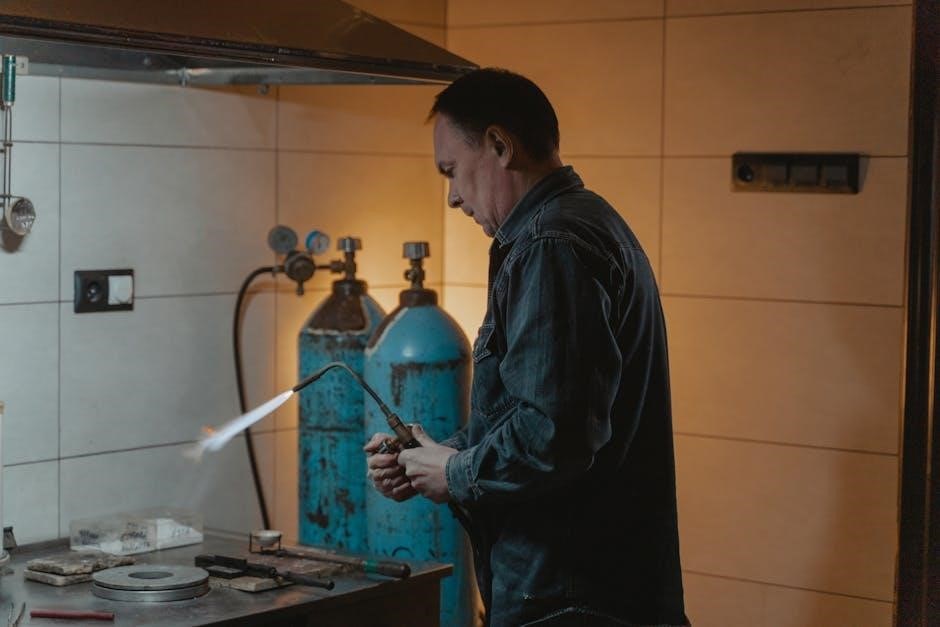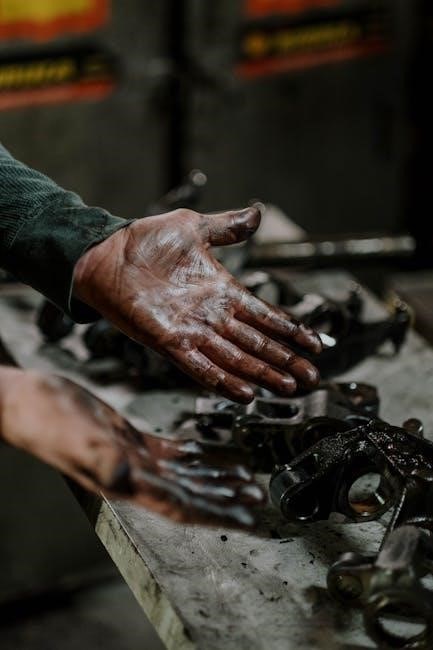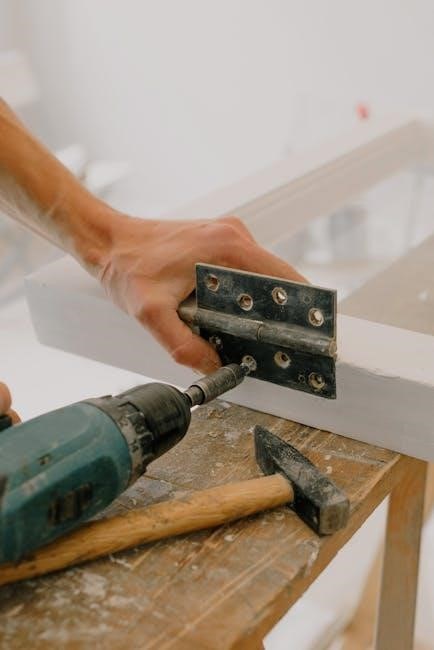The SVZ 18 Maintenance Manual provides essential guidelines for maintaining and servicing the equipment, ensuring optimal performance, safety, and longevity. It covers disassembly, troubleshooting, and proper installation techniques.
1.1 Overview of the SVZ 18 Equipment
The SVZ 18 is a high-efficiency air handling unit designed for multi-zone or single-zone systems. It features advanced engineering for optimal performance and energy savings. The equipment includes a multi-position design, allowing flexible installation in various spaces. With a capacity of 18,000 BTU, it ensures reliable heating and cooling. Key components include a robust blower motor and advanced airflow control. The unit is part of Mitsubishi Electric’s M-Series, known for its durability and innovative technology, making it a popular choice for residential and light commercial applications.
1.2 Importance of Regular Maintenance
Regular maintenance is crucial for ensuring the SVZ 18 equipment operates efficiently and safely. It prevents mechanical issues, reduces energy consumption, and extends the unit’s lifespan. Proper upkeep also minimizes the risk of unexpected breakdowns and ensures compliance with manufacturer guidelines. By following the maintenance manual, users can identify and address potential problems early, maintaining optimal performance and reliability. Regular servicing is essential for preserving the equipment’s functionality and ensuring it continues to meet the desired heating and cooling requirements effectively.

Pre-Maintenance Checks
Before performing maintenance on the SVZ 18, ensure all safety precautions are followed, and necessary tools are available. Verify proper installation and operation to avoid risks like electric shock or water leakage.
2.1 Safety Precautions
Before starting any maintenance on the SVZ 18, ensure all safety precautions are strictly followed to prevent potential hazards. Always disconnect the power supply and verify proper installation to avoid risks such as electric shock, water leakage, or fire. Service personnel must carefully read the operating instructions and installation manual to understand safety protocols. Proper handling of electrical components and refrigerants is essential to ensure safe and efficient maintenance. Adhere to all manufacturer guidelines to prevent accidents and maintain system integrity.
2.2 Tools and Equipment Required
Proper tools and equipment are essential for safe and effective maintenance of the SVZ 18. Common tools include screwdrivers, pliers, and wrenches for disassembly and adjustments. A terminal emulator may be needed for advanced diagnostics, as outlined in the manual. Ensure all tools are compatible with the equipment specifications to avoid damage. Refer to the manual for specific requirements, such as UNF1/2 fittings for R410A systems. Having the correct tools on hand ensures efficient and safe completion of maintenance tasks.

Disassembly Instructions
Disassembly requires careful planning and adherence to safety protocols. Begin by powering down the unit and securing all components. Remove external panels first, followed by internal assemblies, ensuring all connections are documented for reassembly. Refer to specific guides for detailed steps on handling sensitive parts.
3.1 Terminal with Locking Mechanism
The terminal with a locking mechanism is a critical component for securing electrical connections. To disassemble, first release the locking tabs using a flathead screwdriver. Gently pull the terminal away from the base while ensuring no wires are strained. Remove any additional fasteners or clips holding the terminal in place. Document the wire connections before detaching them to ensure proper reassembly. Use caution to avoid damaging the locking mechanism or associated wiring. Refer to the provided diagrams for precise disassembly steps.
3.2 Detaching Points and Components
When detaching components, start by loosening all fasteners in the correct sequence to avoid misalignment. Use a Torx or hex key for bolts, and gently pry components apart using a plastic tool to prevent damage. Label each connector or wire harness before disconnection for easy reassembly. Support heavy components with a lifting strap or second person to ensure safety. Avoid forced removal, as this may damage mating surfaces. Always refer to the exploded diagrams provided in the manual for clarification on complex assemblies.

Dimensions and Specifications
The SVZ 18 unit measures 48 inches in length, 24 inches in width, and 60 inches in height. It weighs approximately 250 pounds, requiring proper handling during installation. Technical specifications include a voltage range of 208-230V and compatibility with R-410A refrigerant for optimal performance.
4.1 M-Series Multi-Position Air Handler Dimensions
The M-Series air handler is designed for versatility, with dimensions of 40 inches in length, 24 inches in width, and 48 inches in height. It weighs approximately 180 pounds, making it suitable for various installation scenarios. The unit can be mounted horizontally, vertically, or wall-mounted, offering flexibility for different spaces. Its compact design ensures minimal footprint while maintaining optimal performance. The M-Series also features a built-in drain pan and an insulated blower compartment for reduced noise and improved efficiency. These dimensions align with the SVZ 18 system requirements for seamless integration.
4.2 Technical Specifications for Proper Installation
The SVZ 18 requires a 208/230V power supply and operates on R-410A refrigerant. Ensure proper drainage by installing a condensate drain with a minimum 1/4-inch trap. Mounting brackets must support the unit’s weight and align with structural guidelines to prevent vibration. Refrigerant lines should be insulated and routed according to manufacturer instructions. Ensure airflow is unobstructed, and install filters as specified. Compliance with these specifications guarantees optimal performance and extends equipment lifespan, aligning with safety and efficiency standards outlined in the manual.

Troubleshooting and Repair
Identify common issues like error codes or reduced performance. Check for blockages, loose connections, and refrigerant leaks. Refer to diagnostic charts for precise fault identification and repair solutions. Contact manufacturer support for complex problems to ensure system longevity and efficiency.
5.1 Common Issues and Solutions
Common issues with the SVZ 18 include reduced airflow, refrigerant leaks, and error codes. Solutions involve cleaning filters, inspecting refrigerant lines for damage, and resetting systems. Addressing these promptly ensures optimal performance and prevents further damage. Always refer to the manual for specific troubleshooting steps and guidelines to resolve issues effectively.
5.2 Diagnostic Procedures
The SVZ 18 maintenance manual outlines specific diagnostic procedures to identify system issues. Start with a visual inspection of connections and components. Use diagnostic tools to check system parameters and error codes. Verify refrigerant levels and airflow; Isolate faulty components by testing individual circuits. Document findings and refer to troubleshooting charts for precise repairs. Ensure all tests are conducted with safety gear and adherence to manual guidelines for accurate diagnostics.

Regular Maintenance Tasks
Regular maintenance ensures optimal performance. Clean air filters, inspect belts, and lubricate moving parts. Check for wear and tear, and replace components as needed promptly.
6.1 Cleaning and Inspection
Regular cleaning and inspection are vital for maintaining efficiency. Clean air filters, condenser coils, and fan blades to ensure proper airflow. Inspect electrical connections, belts, and hoses for wear or damage. Use compressed air for delicate components and mild detergents for exterior surfaces. Check drain lines for blockages and ensure all screws and fasteners are secure. Perform these tasks quarterly or as needed to prevent dust buildup and potential system failures. Always disconnect power before starting any cleaning or inspection procedure.
6.2 Lubrication and Replacement of Parts
Proper lubrication ensures smooth operation. Apply high-quality, water-resistant grease to moving parts like fan motors and bearings; Inspect belts for cracks or wear and replace them every 5 years or as needed. Check for worn-out seals or gaskets and replace them to maintain system integrity. Always use manufacturer-recommended parts to ensure compatibility. Lubricate annually, or more frequently in dusty environments. Replace any damaged or corroded components promptly to prevent system downtime and maintain efficiency. Consult the manual for specific replacement procedures.

Safety Guidelines
Adhere to safety guidelines to prevent accidents and ensure efficient equipment operation. Always wear protective gear like gloves and safety glasses. Properly handle equipment to avoid injuries, and ensure the workspace is well-ventilated. Follow manufacturer recommendations for safe practices and system maintenance. Keep the area clear of hazards and ensure compliance with installation manuals to prevent damage or malfunction. Safety is paramount for optimal performance and longevity.
7.1 Operating Instructions
Always follow the operating instructions provided in the SVZ 18 maintenance manual to ensure safe and efficient equipment operation. Start by powering up the system gradually, checking for any unusual noises or vibrations. Monitor temperature and pressure gauges to avoid exceeding recommended levels. Regularly inspect controls and sensors to ensure accurate readings. Shutdown procedures must be performed systematically to prevent damage. Adhere to these guidelines to maintain optimal performance and prolong equipment lifespan. Proper operation is key to minimizing risks and ensuring reliability.
7.2 Installation Manual Compliance
Strictly adhere to the installation manual for the SVZ 18 to ensure compliance with safety and performance standards. Follow all outlined steps for proper grounding, electrical connections, and component placement. Use only approved materials and tools to avoid system damage. Failure to comply may void warranties or pose safety risks. Always refer to the manual for specific instructions and guidelines. Compliance ensures optimal performance, energy efficiency, and longevity of the equipment. Proper installation is crucial for maintaining safety and operational integrity.

Installation Instructions
Follow detailed installation instructions for the SVZ 18 to ensure proper setup and functionality. Align components accurately, secure the unit, and connect electrical and refrigerant lines correctly.
8.1 Proper Installation Techniques
Ensure the SVZ 18 is installed on a level, stable surface to maintain balance and prevent vibration. Secure all fasteners tightly to avoid loosening over time. Properly align the unit’s electrical and refrigerant connections, ensuring they are not twisted or pinched. Use appropriate tools for crimping or brazing to avoid leaks. Double-check all connections for tightness and integrity. Test the system under load to confirm proper operation and compliance with manufacturer specifications before finalizing the installation.
8.2 Avoiding Common Installation Mistakes
To ensure a successful installation of the SVZ 18, avoid common errors such as improper alignment of components, which can lead to system inefficiency. Neglecting to secure fasteners tightly may result in vibration and noise. Overlooking the proper handling of refrigerant lines can cause leaks or contamination. Cross-threading during connections is another frequent mistake, leading to potential leaks. Always verify voltage compatibility to prevent electrical issues. Following the manual closely will help avoid these pitfalls and ensure optimal performance.

Technical Specifications
The SVZ 18 operates with R410A refrigerant, featuring a high-efficiency compressor and advanced cooling coils. It requires 230V, 50Hz power and maintains a maximum operating pressure of 290PSI.
9.1 Charge Hose Specifications for R410A
The SVZ 18 charge hoses for R410A refrigerant are designed with durable, high-pressure-resistant materials. They feature a 1/4″ and 3/8″ ODF size range, with a maximum operating pressure of 500PSI; Hoses are insulated to minimize heat transfer and ensure system efficiency. They are compatible with R410A refrigerant properties and must meet SAE J513 standards for reliability. Proper sizing and material selection are critical to maintain performance and avoid refrigerant leaks or system damage during operation.
9.2 High-Tension Side Pressure Requirements
The SVZ 18 system requires precise high-tension side pressure management to ensure optimal performance and safety. The maximum allowable pressure on the high-tension side is 500PSI, with a minimum of 150PSI under operating conditions. Proper pressure regulation prevents system overloading and potential damage. Always use pressure-resistant components and follow manufacturer guidelines for pressure adjustments. Incorrect pressure settings can lead to reduced efficiency, equipment failure, or safety hazards. Regular pressure checks are essential to maintain system integrity and reliability.
Energy Efficiency and Cost Considerations
Maintaining energy efficiency is crucial for reducing operational costs. The SVZ 18 system is designed to optimize power consumption while delivering consistent performance. Regular maintenance ensures minimal energy waste, lowering utility bills over time. Proper insulation, airflow management, and temperature settings also contribute to cost savings. Always refer to the manufacturer’s guidelines for energy-efficient operation.
10.1 Understanding Energy Consumption
Understanding energy consumption patterns is essential for optimizing the SVZ 18 system. The unit’s energy usage varies based on operational modes, load requirements, and environmental conditions. Monitoring consumption helps identify inefficiencies and areas for improvement. Regular maintenance, such as cleaning filters and inspecting coils, plays a significant role in reducing energy waste. Additionally, adjusting settings like temperature and airflow can further enhance efficiency. Always refer to the system’s energy monitoring tools for accurate data and to ensure optimal performance.
10.2 Optimizing Performance for Lower Bills
Optimizing the SVZ 18 system’s performance can significantly reduce energy bills. Upgrading to a programmable thermostat allows precise temperature control, minimizing unnecessary energy use. Sealing duct leaks and ensuring proper insulation prevents heat loss. Installing a high-efficiency air filter improves airflow, reducing strain on the system. Adjusting blower speeds and utilizing smart technology, like smart thermostats, further enhances efficiency. Regularly maintaining and upgrading components ensures the system operates at its best, leading to long-term cost savings and improved performance.
The SVZ 18 maintenance manual provides essential guidelines for optimal performance. Regular upkeep ensures efficiency, safety, and longevity. Adherence to these practices guarantees reliable operation and cost savings.
11.1 Summary of Key Maintenance Practices
Regular inspections, cleaning, and lubrication are vital for the SVZ 18’s performance. Ensure all components are checked and replaced as needed. Always follow the manual’s guidelines to prevent damage and ensure efficiency. Proper maintenance extends equipment life, reduces unexpected breakdowns, and optimizes energy use. Adhering to these practices guarantees reliable operation and minimizes operational costs over time. Consistency in upkeep is key to maintaining peak functionality and safety standards.
11.2 Importance of Adhering to the Manual
Adhering to the SVZ 18 maintenance manual ensures safety, efficiency, and equipment longevity. Deviating from guidelines can lead to malfunctions, void warranties, or even pose safety risks. Proper procedures guarantee optimal performance, reduce energy consumption, and prevent costly repairs. Following the manual also ensures compliance with industry standards and manufacturer recommendations, safeguarding both the equipment and users. Consistent adherence minimizes downtime and extends the system’s lifespan, making it a critical aspect of responsible ownership and operation.

Additional Resources
Access online manuals, guides, and manufacturer support for detailed instructions and troubleshooting. These resources provide comprehensive assistance for optimal SVZ 18 maintenance and operation.
12.1 Online Manuals and Guides
The SVZ 18 maintenance manual is available online through the manufacturer’s official website. It provides detailed instructions, diagrams, and troubleshooting tips. Users can access downloadable PDF versions, ensuring easy reference. The online manual is regularly updated to reflect the latest technical specifications and maintenance practices. Additional resources include video tutorials and FAQs, offering comprehensive support for technicians and operators. These guides are designed to streamline maintenance processes and ensure optimal performance of the SVZ 18 equipment.
12.2 Manufacturer Support and Contact Information
The manufacturer offers dedicated support for the SVZ 18 maintenance manual. For inquiries or technical assistance, contact their support team via email at support@manufacturer.com or call 1-800-TECH-SUPPORT. Visit their official website for detailed contact information and regional offices. The manufacturer also provides a 24/7 helpdesk for urgent issues. Ensure to have your equipment serial number ready for faster assistance. Their team is committed to resolving queries related to maintenance, repairs, and troubleshooting efficiently.
